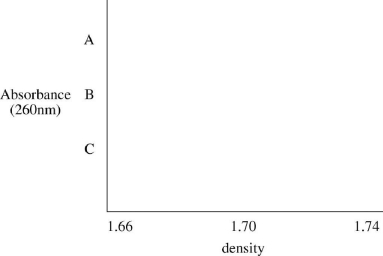Assume that you grew a culture of E. coli for many generations in medium containing 15N (from the ammonium ion), a heavy isotope of nitrogen. You extract DNA from a portion of the culture and determine its density to be 1.723 gm/cm3 (call this sample
A). You then wash the remaining E. coli cells and grow them for one generation in 14N, extract the DNA from a portion of the culture, and determine its density to be 1.715 gm/cm3 (call this sample
B). You let the culture grow for one more generation in 14N, and extract the DNA (call this sample
C) is then heated to completely denature the double-stranded structures, cooled quickly (to keep the strands separate), and subjected to ultracentrifugation. Present the centrifugation profiles for heat-denatured DNA (samples A, B, and
C) that you would expect. Use the graph below. (Note: Although not the case, assume that single-stranded DNA has the same density as double-stranded DNA.)

C). Each sample of DNA (A, B, and
Correct Answer:
Verified
Q1: Given that the origin of replication is
Q2: What three possible models were suggested to
Q15: Which cluster of terms accurately reflects the
Q18: Which of the following terms accurately describes
Q19: DNA polymerase I is thought to add
Q22: Given the accompanying diagram, assume that a
Q23: Describe the function of the RecA protein.
Q28: Which protein is responsible for the initial
Q30: Given that the nature of DNA replication
Q35: Briefly describe what is meant by the
Unlock this Answer For Free Now!
View this answer and more for free by performing one of the following actions

Scan the QR code to install the App and get 2 free unlocks

Unlock quizzes for free by uploading documents